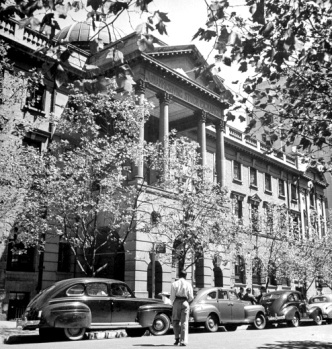
In a move that may ease investors concerns, Peru’s President-elect Ollanta Humala formally named Luis Miguel Castilla as Finance Minister and also announced that Central Bank President Julio Velarde would remain in his post. He first made the announcement of Castilla’s appointment on June 20th via Twitter and it was later confirmed by his Ganu Peru party in an official email today.
Humala, the controversial former army officer that sent Peru’s financial markets into turmoil, takes office on July 28th. These appointments are seen by many as an effort to reassure investors that any plans the new administration may have to raise taxes, increase mining royalties or enlarge state control will not erode economic growth.
Castilla, who served as departing President Alan Garcia’s Deputy Finance Minister, is considered to be a fiscal moderate and holds a doctoral and master’s degrees from Johns Hopkins University. Castilla is a former consultant to the World Bank and wrote a chapter on Latin America and East Asia trade strategies in a 2008 book entitled “Growth and Development in Emerging Market Economies.” Patricia Teullet, general manager of the Peruvian Exporters’ Association and a critic of Humala stated that naming Castilla is a “magnificent” sign that Humala has heard investors’ concerns.
Humala also appointed Carlos Herrera Descalzi as Peru’s Energy and Mining Minister. Descalzi most recently served as Dean of the College of Engineers. In a recent interview with Peru21 the newly appointed minister said he had already spoken with a number of mining companies and members of the National Mining and Petroleum Society who were willing to negotiate a “windfall tax” on their profits. He stated that the purpose is to meet the needs of the population and to reduce social conflicts, which have been growing faster than Peru’s booming economy. Descalzi also said, “It is a crucial issue, because the population is convinced that mining can contribute more to Peru.”
Ollanta Humala’s path to President-elect of Peru hit Peruvian mining stocks hard. As Peruvians went to the polls MiningFeeds.com looked at 10 Canadian listed mining stocks, which, on average, were already down 18.9 percent prior to his victory – CLICK HERE – for the article.

Last year, political strategist and monetary economist Cedric Muhammad said, “At 29-years old and a base of support among the youth and business class, Julius Malema could not be a more important figure to watch as the political and financial marketplaces determine how the nation’s (South Africa) wealth should be distributed and allocated.” Mr. Muhammad is currently a Member of the African Union’s First Congress of African Economists. Evidently, Mr. Muhammad knew what he was talking about.
In a surprising move last September, the ruling African National Congress party decided to study nationalization in response to the repeated requests of Julius Malema, the controversial leader of the party’s Youth League. The decision cast a dark cloud over South Africa’s mining industry.
Citibank analysts estimate that South Africa has more than $2.5 trillion in mineral reserves ranking it the world’s richest nation by commodity wealth, followed by Russia and Australia. According to the Mines Ministry, mining generates 30 percent of South Africa’s export revenue, 18 percent of its corporate taxes and a half a million direct jobs. The country is the world’s biggest producer of platinum and chrome, and the third largest gold producer. Mining companies comprise roughly 43 percent of the value of the Johannesburg Stock Exchange. One would think that given the current resource boom South Africa should be thriving, but frequent labor problems and prolonged power outages have affected the profitability of the mining industry. And Johannesburg’s gold fields, the source of 40 percent of all the gold ever mined, are in decline. Over the last decade, output has shrunk by more than 7 percent a year.
Today, South Africa’s former Reserve Bank governor, Tito Mboweni, stated that he felt the mining nationalization debate was being handled recklessly. Mr. Mboweni said, “The manner in which the issue has been raised has lacked an appreciation for the consensus-building spirit that has informed the construction of new and ongoing agreement in our society.” And last week, Mark Cutifani, CEO of South African major AngloGold Ashanti Ltd. (NYSE:AU) and Vice President of South Africa’s Chamber of Mines, said in a written editorial, “We will not deal with these issues through business simply by shouting louder than the African National Congress Youth League. Young people are justified in calling for broad social change. The logic behind the call for nationalization needs to be sensibly debated rather than angrily dismissed.”
Bridgette Radebe, Chairman of Mmakau Mining and the wife of South Africa’s justice minister, stated at a recent conference that a failure to address the ongoing economic imbalances in South Africa could lead to a “situation like Zimbabwe.” Under Zimbabwe’s Empowerment Act, enacted in 2008, foreign-owned miners must cede or sell 51 percent of their shares to black citizens or state-approved agencies.
Given the ongoing geopolitical instability in South Africa, we look at three high-profile TSX listed mining stocks that are doing business in Africa’s largest economy.
Platinum Group Metals Ltd. (TSX: PTM)
Platinum Group Metals holds significant mineral rights in the Bushveld Complex in South Africa which, from the perspective of platinum, is the place to be. The Bushveld Complex is the world’s largest primary reserve of platinum and South Africa produce’s 80% of the world’s annual platinum production. Platinum, among the rarest and costliest of metals, is also one of the most green. Platinum is so rare that all of the metal ever mined would fill a room measuring less than 25 feet on each side. The metal has many critical commercial uses, but the primary demand driver today is the automotive industry. Catalytic converters that control harmful automobile emissions now account for 60% of the annual demand for platinum.
Shares of Platinum Group Metals have not performed well since the move by the African National Congress party to open the debate on nationalization last September. At the time, the company’s shares were trading up hitting the $2.40 range but have since fallen to under $1.80.
Frontier Rare Earths Ltd. (TSX: FRO)
The nationalization debate didn’t stop the $60 million IPO of Frontier Rare Earths late last year. Frontier is one of many new exploration and development stage companies listed on the TSX trying to stake a future on the red-hot rare earths scene. Frontier’s flagship project is the Zandkopsdrift rare earth element deposit in the Northern Cape province of South Africa. The company’s NI 43-101 technical report states that Zandkopsdrift is one of the largest known undeveloped rare earth deposits outside China. On July 13th, 2011, Frontier signed a heads of agreement with Korea Resources Corporation, the Korean government-owned mining and natural resource investment company, to form a strategic partnership around the company’s Zandkopsdrift project. Terms of the agreement are expected to be finalized in the fourth quarter of 2011.
Frontier Rare Earths was featured by MiningFeeds.com in 5 Most Interesting Rare Earth Stocks – CLICK HERE – for the article. And with South Africa’s nationalization debate heating up of late, things are certainly getting more interesting by the day.
Uranium One Inc. (TSX: UUU)
Uranium One is a mining and exploration company with interests in in South Africa and Australia. Unfortunately for shareholders it appears business hasn’t been going much better in Australia. Sort through Uranium One’s financial statements and you’ll find a $113.5 million writedown at its Honeymoon Uranium project in Australia late last year. But with the Japanese disaster now four months past, the company appears to be making a modest comeback. Shares of the embattled uranium miner are currently trading at $3.16 up nicely from its $2.50 lows reached last month.
For last month’s related article entitled – “Is it time for a uranium sector rebound?” – CLICK HERE.

After buying your morning double-double at Tim Horton’s, do you ever wonder where the coins came from? Long before they were turned into the money that we all carry around with us in our pockets, they were raw metals hidden in the earth. How do mining companies know where to drill to find metal deposits? Once they find the deposits, how do these companies extract the minerals? The answers almost always lie in mining technologies.
In mining, technologies ranging from IT and computer software systems that provide 3D models of resource deposits to chemical process technologies used to separate minerals from ore have improved the efficiency of extraction by leaps and bounds; even over the past decade. Yet some mining technologies have been around for centuries. For the production of aluminum, the first part of the process was invented in 1887 by Russian scientist Karl Bayer. Bayer discovered that aluminium oxide (alumina) could be produced from bauxite when using sodium hydroxide. The second part of the process, the Hall-Héroult process, was developed one year earlier in 1886. It involves dissolving alumina in molten cryolite and electrolysing the molten salt bath to obtain pure aluminium metal. The process was discovered independently by American chemist Charles Martin Hall and French scientist Paul Héroult. In 1888, Hall opened the first large-scale aluminium production plant in Pittsburgh, which eventually evolved into the Alcoa corporation.
Today, we look at three mining companies listed in Canada that are developing innovative mining process technologies. We start with an aluminum miner in the province of Quebec that is going up against the 124 year old Bayer process.
Orbite V.S.P.A. Inc. (TSX-V: ORT.A)
It has long been known that alumina can be refined from aluminous clay deposits but this process is not widely exploited because, historically, the quality and cost of alumina from clay has not been competitive with alumina from bauxite using the Bayer process. Orbite has a patented process for extracting alumina from aluminous clay and in February, 2011 the company completed a pilot plant with a production rate of one tonne per day of alumina. The plant is reportedly capable of producing both smelter grade alumina and high-purity alumina in a cost-effective manner.
On July 7th, 2011, Orbite closed a $57.5 million bought deal financing through its lead underwriter Mackie Research Capital Corporation. Mackie Research analyst Matt Gowing calls Orbite a “game-changing alumina production company” and has a 1 year price target of $7.50 on the company’s stock. Mr. Gowing states, “According to Orbite’s engineering design and pilot plant work thus far, the company is targeting a cash cost of operating the metallurgical plants to be approximately less than half of the $280 cost per tonne or ($140/tonne) incurred by bauxite-based alumina producers”.
Not only does Orbite control their technological process, they also control their resource supply. Recently, the company updated its NI 43-101 compliant resource estimate at the Grand Vallee property from 75-300 million tonnes to 1 billion tonnes of aluminous clay grading, at an average, 23.13% alumina. Shares of the company have been on a tear in 2011. Starting the year at $0.90, Orbite’s shares are currently trading at $3.38 and has lately been one of the TSX’s most actively traded stocks.
Verde Potash PLC (TSX-V: NPK)
Verde Potash (formerly Amazon Mining) is developing the Verdete slate, or green slate, potash project in Brazil. On March 8, 2010 Verde Potash received an initial National Instrument 43-101 compliant inferred mineral resource estimation of 105 million tonnes at 10.3% K20 inferred resource for the project.
But this junior potash mining company also utilizes a little technology. On December 1st, 2010, the company filed a patent application in the U.K. for the production of conventional potash product, muriate of potash (KCl) and sulphate of potash (SOP) from Verdete slate. The company plans on utilizing a relatively new extraction process that heats Verdete slate to almost 1,100 degrees Celsius to extract the potash. This process results in a new fertilizer, ThermoPotash, that the company believes will be more suited to the needs of the Brazilian marketplace.
Brazilian soil is much more acidic than soil in other parts of the world, and the problem has been compounded by the agricultural use of potassium chloride. And potassium chloride, the fertilizer produced in Canadian potash mines, also washes away too easily in Brazil’s heavy tropical rains. Shares of Verde Potash currently trade in the $7.50 range valuing the company at over $240 million.
Alexander Mining PLC (TSX-V: AXD)
Alexander Mining is a relatively new issuer on the TSX Venture Exchange hitting the Canadian market in January earlier this year. The company is also listed on the AIM Exchange in the U.K. Alexander is a mining and mineral processing technology company. Through it’s wholly owned subsidiary MetalLeach Limited, Alexander controls two proprietary (patent pending) hydrometallurgical mineral processing technologies. These technologies are designed for the extraction processes of certain base metal deposits.
Of the aformentioned techniques, the copper process has been demonstrated at pilot plant scale for heap leaching and at bench scale for agitated leaching. The cobalt process has been bench scale tested for both heap and agitated leaching. While development of the zinc process has led to a new solvent extraction process for which patents are pending. Shares of Alexander mining last traded at $0.11 on the TSX-V Exchange valuing the company at $15 million.

In a note to clients today, Goldman Sachs said it expects gold prices to continue to climb in 2011 given the current low level of U.S. real interest rates. “We recommend near-dated consumer hedges in gold,” the investment bank stated. The often maligned U.S. based investment firm expects further increases in commodity returns later this year and into 2012 as demand growth is still likely to be sufficient to tighten key markets. In addition to gold, Goldman also likes copper and zinc.
Goldman highlights European debt, the ongoing battle between balancing inflation with growth in China and mixed data from several major economies as drivers that are expected to result in near-term market volatility. And volatile markets are generally good for gold.
Gold futures tumbled to a six-week low on July 1 as it became apparent that Greece was going to resolve their debt issues and prevent default effectively curbing demand for the metal as a safe haven investment. U.S. Commodities Futures Trading Commission data shows that hedge fund managers and other institutional investors decreased their net-long positions in New York gold futures by 18 percent during the last week of June. At month’s end, gold touched a low of just under $1,480. Since then, gold has quietly rallied and is currently trading at just under $1,530, up almost $50 an ounce.
Canadian investors appear to agree with Goldman Sachs. Gold stocks are among the TSX Exchange’s top traded equities of late. And today, we take a look at three gold miners that are on the most active list.
Argonaut Gold Inc. (TSX: AR)
In a results driven market, the market took notice when Argonaut released their first quarter 2011 results on June 6th, 2011. The company announced record revenue of $25.7 million and record net income of $5.9 million for seven cents per share. Since then, daily share volume has picked up considerably and over 2.5 million shares have exchanged today making it one of the TSX’s most active issuers. Argonaut Gold is a Canadian junior gold producer and exploration company with mining operations in Mexico.
About the results, Pete Dougherty, Argonaut’s President & CEO, said, “The year of 2011 began with a substantial increase in reserves and resources at El Castillo. This quarter marks the second quarter of an annualized production rate of 72,000 ounces, with cash costs at $590 per gold ounce sold. This is in line with company guidance for 2011.” Argonaut’s shares are up $0.75 since the first quarter results were released in early June and are currently trading at $5.75.
Avion Gold Corp. (TSX: AVR)
Shares of Avion Gold have been trending up recently, from the $1.50 range, since the company announced drill results from its Hounde project in the West African country of Burkina Faso. The results announced on June 9th, 2011 included 2.80 grams per tonne Au over 53.7 meters. Shares of Avion Gold made a further move yesterday, Wednesday, July 6th, after the company announced an initial mineral reserve estimate of almost 1 million ounces of gold over seven deposits and several stockpiles of ore which comprise their Tabakoto project in Mali, West Africa. Avion’s closed at $2.40 up $0.30 on the day; currently, over 2.5 million shares have traded hands and are currently priced at $2.23.
Last week, Avion’s counterpart in West Africa, Volta Resources Inc. (TSX:VTR), which also has operations in Burkina Faso and Mali, posted the third largest weekly gain on the TSX Exchange – CLICK HERE – for the article.
Sandstorm Gold Ltd. (TSX-V: SSL)
On the Venture board, Sandstorm Gold is the second most actively traded stock today with over 1.3 million shares being exchanged by midday. Shares of Sandstorm Gold have also been on the rise since early June after the company announced drill results from six new holes at the Aurizona mine which included 48 meters at 3.29 grams per tonne gold. The news was announced in association with Sandstorm’s partner Luna Gold Corp. (TSX-V:LGC). In accordance with Sandstorm’s gold purchase agreement with Luna, Sandstorm is entitled to purchase 17 per cent of the life-of-mine gold produced from the Aurizona mine at a per ounce price equal to the lesser of US$400 and the then prevailing market price.

Like most Canadians, the TSX took a break for Canada day celebrations on Friday after posting four consecutive positive days. And to the south, U.S. stocks posted their biggest weekly rally in two years with the Dow Jones Industrial Average rising 648 points after Greece took action to avoid default on its debt.
“It’s a week of major reversal,” said Stephen Lieber, Chief Investment Officer of Alpine Woods Capital Investors, a New York investment firm with $7 billion under management.
Stocks rose this week after Greek Prime Minister George Papandreou secured enough votes to pass the first part of an austerity plan aimed at meeting European Union aid requirements and lawmakers backed a bill on June 30 to authorize the measure. Greece could receive as much as 85 billion euros in new financing, including contributions from European banks and private investors, in a second bailout aimed to prevent default by the debt-laden nation.
“People are relieved that the Greek situation is seemingly contained for the next couple of months. Also the most recent economic news out of the U.S. has not been as bad as feared,” said Lex van Dam, hedge fund manager at Hampstead Capital, which manages nearly a half a billion dollars. TSX miners fared well as investors’ risk appetite reflected the sentiments of Mr. van Dam. We take a look at the three top performing mining stock on the TSX in a week where investors let out a collective sigh of relief and the bulls outnumbered the bears.
1. Capstone Mining Corp. (TSX: CS)
Weekly gain: 20.5%
Closing price: $3.59
On July 20th, Capstone Mining released the results of an initial mineral resource estimate for the Mala Noche Footwall zone (MNFWZ) at the Cozamin mine in Zacatecas, Mexico. Measured + indicated resources were reported to be 74.2 million pounds of copper grading 2.32% and 1.7 million ounces of silver grading 36.6%. Earlier that week, Capstone closed the acquisition of Far West Mining. “The size and grade of this new mineral resource estimate allows Capstone to now consider production expansion scenarios as well as extended mine life in an upcoming prefeasibility study to begin in the third quarter of 2011,” said Brad Mercer, Vice President Exploration.
On May 26th, 2011, TD Newcrest analyst Craig Miller reissued a buy rating on Capstone and has a 12 month price target of $4.75 on the stock, down slightly from TD’s $5.50 target issued late last last year.
2. Labrador Iron Mines (TSX: LIM)
Weekly gain: 20.1%
Closing price: $12.25
On July 30th, Labrador iron Mines reported a year end loss of $3.97 million in their fiscal 2011. But tucked in the press release was a sound-bite that investors had been waiting for. On June 29, 2011, the first loaded iron ore train departed the company’s Silver Yards facility for the Port of Sept-Iles. This historic event is the first commercial iron ore train from the Schefferville area in almost 30 years.
Labrador Iron Mines was featured by MiningFeeds.com as one of 10 Base Metal Stocks to Watch in 2011 and Haywood Securities analyst Geordie Mark noted, “Labrador Iron Mines is set to become Canada’s next iron ore producer coming into production this month. The company intends to deploy the cash from its recent financing and cash-flow from operations to expand output over the next few years so the timing looks perfect to take advantage of elevated iron ore prices.” CLICK HERE – for the full article.
3. Volta Resources Inc. (TSX: VTR)
Weekly gain: 19.0%
Closing price: $1.63
On July 29th, Volta released an updated NI 43-101-compliant mineral resource estimate for the Kiaka gold project in Burkina Faso, . The report, prepared by SRK Consulting United Kingdom, highlighted a 3.01 million ounce of measured + indicated gold resource. “Our drilling programs have more than doubled the mineral resource base from last year’s estimate at Kiaka while also significantly increasing the confidence of the geological model,” stated Kevin Bullock, Volta’s president and chief executive officer.
Burkina Faso, formerly called the Republic of Upper Volta, was renamed on August 4th, 1984, by then President Thomas Sankara in an effort to shed the country’s colonial past. Figuratively, “Burkina” means “men of integrity” in Mòoré and “Faso” means “father’s house” in Dioula – from the two major languages spoken in the West African nation. For his efforts, Mr. Sankar was later killed by an armed gang with twelve other officials in a coup organised by his former colleague, Blaise Compaoré. Lately, the incumbent government has been dealing with rebellious soldiers who have taken to the streets demanding daily food allowances and a housing subsidies among other things. On May 31st, the presidential guard was sent to put down the most recent rebellion. Nearly 60 soldiers were arrested, according to military authorities, who have announced that they will be charged with “rebellion and theft”.
If you would like to receive our free newsletter via email, simply enter your email address below & click subscribe.
CONNECT WITH US
Tweets
Tweet with hash tag #miningfeeds or @miningfeeds and your tweets will be displayed across this site.
MOST ACTIVE MINING STOCKS
Daily Gainers
 Lincoln Minerals Limited Lincoln Minerals Limited |
LML.AX | +125.00% |
      |
GCR.AX | +33.33% |
      |
CASA.V | +30.00% |
      |
AHN.AX | +22.22% |
      |
ADD.AX | +22.22% |
      |
AZM.V | +21.98% |
      |
NSE.V | +21.05% |
      |
DYG.V | +18.42% |
      |
AAZ.V | +18.18% |
      |
GLA.AX | +17.65% |


 Follow us on Twitter
Follow us on Twitter Become our facebook fan
Become our facebook fan








